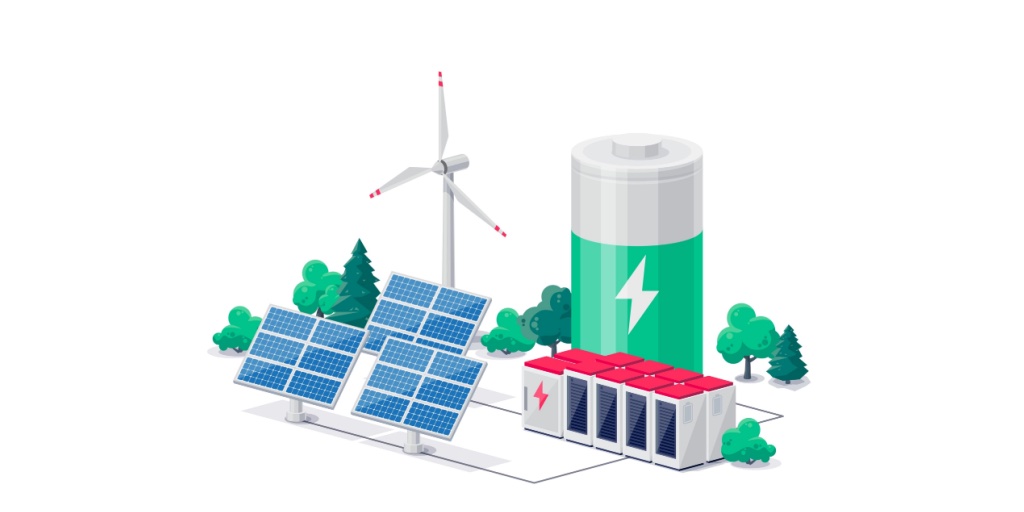Unveiling the Lifespan of Solar Panel Batteries: How Long Do They Last?
Solar panel systems have emerged as a popular and sustainable energy solution, allowing individuals and businesses to harness the power of the sun for electricity generation. Integral to these systems are solar panel batteries, which store excess energy for use during periods of low sunlight or high demand. Understanding the lifespan of these batteries is crucial for evaluating the long-term viability and economic feasibility of solar energy systems.
Understanding Solar Panel Batteries
Solar panel batteries are integral components of off-grid and grid-tied solar energy systems, serving as energy storage units to capture and store excess electricity generated by solar panels for later use. To comprehend their significance fully, it's essential to delve deeper into their functionality, types, and role within solar energy systems.

A. Functionality of Solar Panel Batteries
l Energy Storage: Solar panel batteries store the excess electricity generated by solar panels during periods of high sunlight. This stored energy is then utilized during times of low sunlight or high energy demand, ensuring a consistent and reliable power supply.
l Power Management: Solar panel batteries facilitate effective power management within solar energy systems. They regulate the flow of electricity, balancing energy supply and demand to optimize system performance and efficiency.
l Backup Power: In off-grid solar energy systems, solar panel batteries provide backup power during periods of low sunlight or grid outages. This ensures continuous power supply, enhancing energy reliability and resilience.
B. Types of Solar Panel Batteries
Solar panel batteries come in various types, each with its own characteristics, performance attributes, and suitability for different applications:
l Lead-Acid Batteries: Lead-acid batteries are one of the most common types used in solar energy systems. They are cost-effective, reliable, and well-suited for off-grid applications. However, they have limited cycle life and require regular maintenance.
l Lithium-Ion Batteries: Lithium-ion batteries offer higher energy density, longer cycle life, and faster charging capabilities compared to lead-acid batteries. They are ideal for grid-tied solar systems and applications requiring high-performance energy storage solutions.
l Other Battery Chemistries: In addition to lead-acid and lithium-ion batteries, other battery chemistries such as nickel-cadmium (Ni-Cd), nickel-metal hydride (NiMH), and flow batteries are used in specific solar energy applications, each offering unique advantages and limitations.
C. Role within Solar Energy Systems
Solar panel batteries play a crucial role in maximizing the efficiency, reliability, and resilience of solar energy systems:
l Energy Optimization: Solar panel batteries enable the efficient utilization of solar energy by storing excess electricity generated during periods of peak sunlight and delivering it when needed, reducing reliance on grid power and optimizing self-consumption.
l Grid Integration: In grid-tied solar energy systems, solar panel batteries support grid integration by providing ancillary services such as frequency regulation, voltage support, and peak shaving. This enhances grid stability and reliability while facilitating the integration of renewable energy sources.
l Energy Independence: Solar panel batteries empower users to achieve energy independence by storing and utilizing solar energy on-site, reducing dependence on centralized power sources and mitigating the impact of grid outages or disruptions.
Understanding the functionality, types, and role of solar panel batteries within solar energy systems is essential for designing, installing, and operating efficient and reliable solar energy solutions. With the right choice of batteries and proper system configuration, solar panel batteries can significantly enhance the performance and value of solar energy systems for both residential and commercial applications.
Factors Influencing Battery Lifespan
The lifespan of solar panel batteries is influenced by a variety of factors, ranging from battery chemistry and usage patterns to environmental conditions and maintenance practices. Understanding these factors is essential for maximizing battery longevity and optimizing the performance of solar energy systems.
A. Battery Chemistry and Composition
l Lead-Acid Batteries: Lead-acid batteries, including flooded, gel, and absorbed glass mat (AGM) types, have different characteristics and lifespans. Factors such as plate composition, electrolyte formulation, and construction impact the longevity of lead-acid batteries.
l Lithium-Ion Batteries: The chemistry of lithium-ion batteries, including cathode and anode materials, electrolyte composition, and cell design, influences their lifespan. Factors such as electrode degradation, electrolyte decomposition, and thermal stability affect the performance and longevity of lithium-ion batteries.
B. Depth of Discharge (DoD) and Charging Cycles
l Depth of Discharge (DoD): The depth to which a battery is discharged during each cycle, expressed as a percentage of its total capacity, affects its lifespan. Shallower discharge cycles typically result in longer battery life, as deeper discharges can accelerate electrode degradation and reduce cycle life.
l Charging Cycles: The number of charging and discharging cycles a battery undergoes over its lifetime impacts its longevity. While some battery chemistries, such as lithium-ion, are more tolerant of frequent cycling, others, like lead-acid, may experience reduced lifespan with excessive cycling.
C. Environmental Factors
l Temperature: High temperatures can accelerate chemical reactions within batteries, leading to increased degradation and reduced lifespan. Conversely, low temperatures can decrease battery performance and efficiency. Maintaining optimal operating temperatures is essential for maximizing battery lifespan.
l Humidity: Excessive humidity can contribute to corrosion and degradation of battery components, particularly in lead-acid batteries. Proper ventilation and moisture control can help mitigate the impact of humidity on battery lifespan.
l Ventilation and Air Quality: Adequate ventilation is crucial for dissipating heat and preventing the buildup of gases during battery operation. Poor air quality, including exposure to pollutants and corrosive gases, can accelerate battery degradation and reduce lifespan.
D. Maintenance and Care Practices
l Regular Inspection: Periodic inspection of battery terminals, connections, and electrolyte levels can help identify potential issues and prevent premature failure. Visual inspection, voltage testing, and specific gravity measurements are common maintenance practices.
l Proper Charging: Following manufacturer-recommended charging profiles and avoiding overcharging or undercharging can extend battery life. Charge controllers and battery management systems (BMS) help regulate charging parameters and protect batteries from damage.
l Equalization and Balancing: Periodic equalization and balancing of battery cells can help maintain uniform charge distribution and prevent capacity imbalances. This is particularly important for lead-acid batteries to mitigate sulfation and stratification effects.
l Temperature Control: Implementing temperature control measures, such as thermal insulation, ventilation, and temperature monitoring, can help optimize battery performance and prolong lifespan in both hot and cold climates.
Understanding and addressing these factors are essential for optimizing the lifespan and performance of solar panel batteries. By implementing appropriate maintenance practices, monitoring environmental conditions, and selecting battery chemistries suited to specific applications, solar energy system owners can maximize the return on investment and ensure reliable operation over the lifespan of their systems.

Estimating Battery Lifespan
Estimating the lifespan of solar panel batteries is crucial for planning and managing solar energy systems effectively. While manufacturers provide specifications and warranties, real-world battery lifespan can vary depending on usage patterns, environmental conditions, and maintenance practices. Several methods and considerations can help in estimating battery lifespan accurately.
A. Manufacturer Specifications and Warranties
l Specified Lifespan: Battery manufacturers typically provide specifications indicating the expected lifespan of their products under specific operating conditions. This may include the number of cycles, depth of discharge (DoD), and operating temperature range.
l Warranty Coverage: Manufacturers often offer warranties covering a certain number of years or cycles, guaranteeing performance and reliability within specified parameters. Understanding warranty terms and conditions is essential for assessing long-term reliability and support.
B. Historical Performance Data
l Field Testing: Real-world performance data from field installations provide valuable insights into battery lifespan and reliability. Analyzing historical data, including cycle counts, discharge profiles, and failure rates, can help estimate average lifespan and anticipate maintenance needs.
l Case Studies: Case studies and reports documenting battery performance in specific applications and environments offer practical examples of expected lifespan and performance. Comparing case study data with manufacturer specifications can help validate estimates and inform decision-making.
C. Predictive Modeling and Simulation Tools
l Battery Management Systems (BMS): Advanced battery management systems incorporate algorithms and predictive analytics to monitor battery health, assess performance trends, and estimate remaining lifespan. BMS data can inform maintenance schedules and optimize battery usage to prolong lifespan.
l Cycle Life Models: Mathematical models based on battery chemistry, operating conditions, and usage patterns can predict battery lifespan with a high degree of accuracy. Cycle life models consider factors such as DoD, temperature, and charging profiles to estimate degradation over time.
D. Environmental and Operational Considerations
l Environmental Conditions: Environmental factors such as temperature, humidity, and air quality can impact battery lifespan significantly. Assessing environmental conditions at the installation site and implementing measures to mitigate adverse effects can prolong battery life.
l Usage Patterns: Understanding how batteries are used, including typical discharge depth, charging frequency, and load profiles, is essential for estimating lifespan. Heavy cycling, frequent deep discharges, and improper charging practices can accelerate battery degradation.
E. Performance Monitoring and Maintenance
l Regular Monitoring: Ongoing monitoring of battery performance, including voltage, temperature, and state of charge, helps detect anomalies and trends indicative of degradation or impending failure. Establishing baseline performance metrics and tracking changes over time facilitates lifespan estimation.
l Maintenance Practices: Implementing proactive maintenance practices, such as cleaning terminals, equalizing cells, and conducting routine inspections, can extend battery lifespan and minimize the risk of premature failure. Adhering to manufacturer recommendations and industry best practices is essential for optimizing performance and reliability.
Estimating the lifespan of solar panel batteries requires a comprehensive understanding of battery chemistry, operating conditions, and usage patterns. By leveraging manufacturer specifications, historical data, predictive modeling tools, and environmental considerations, solar energy system owners can make informed decisions, optimize battery performance, and maximize the return on investment over the lifespan of their systems.

Longevity of Different Battery Types
Solar panel batteries come in various types, each with its unique characteristics, performance attributes, and lifespan considerations. Understanding the longevity of different battery types is essential for selecting the most suitable option based on application requirements, budget constraints, and maintenance considerations.
A. Lead-Acid Batteries
Lifespan: Lead-acid batteries typically have a lifespan ranging from 3 to 20 years, depending on factors such as battery chemistry, usage patterns, and maintenance practices.
Advantages:
l Cost-Effectiveness: Lead-acid batteries are relatively inexpensive compared to other battery types, making them an attractive option for budget-conscious consumers.
l Robustness: Lead-acid batteries are durable and tolerant of overcharging and deep discharges, making them suitable for off-grid and remote applications.
l Familiarity: Lead-acid technology has been widely used for decades, with established manufacturing processes and service infrastructure.
Limitations:
l Limited Cycle Life: Lead-acid batteries have a finite number of charge-discharge cycles, typically ranging from 300 to 2000 cycles depending on depth of discharge and maintenance practices.
l Maintenance Requirements: Lead-acid batteries require regular maintenance, including topping up electrolyte levels, equalizing charges, and monitoring specific gravity.
l Environmental Impact: Lead-acid batteries contain toxic materials such as lead and sulfuric acid, posing environmental and health risks if not handled and disposed of properly.
B. Lithium-Ion Batteries
Lifespan: Lithium-ion batteries offer longer lifespans compared to lead-acid batteries, typically ranging from 5 to 15 years depending on factors such as battery chemistry, usage patterns, and environmental conditions.
Advantages:
l High Energy Density: Lithium-ion batteries provide higher energy density and specific energy compared to lead-acid batteries, resulting in lighter weight and smaller footprint for a given capacity.
l Long Cycle Life: Lithium-ion batteries can withstand a greater number of charge-discharge cycles, often exceeding 2000 cycles with proper maintenance and care.
l Fast Charging: Lithium-ion batteries support rapid charging, allowing for shorter charging times and increased flexibility in energy management.
Limitations:
l Cost: Lithium-ion batteries are generally more expensive upfront compared to lead-acid batteries, although prices have been decreasing as technology advances and economies of scale improve.
l Temperature Sensitivity: Lithium-ion batteries are sensitive to temperature extremes, with performance and lifespan being adversely affected by exposure to high temperatures.
l Safety Concerns: Lithium-ion batteries have been associated with safety risks such as thermal runaway and fire, although advancements in battery management systems and safety features have mitigated these concerns.
C. Other Battery Chemistries
l Nickel-Cadmium (Ni-Cd) Batteries: Ni-Cd batteries offer good cycle life and durability but are less commonly used in solar energy applications due to environmental concerns associated with cadmium.
l Nickel-Metal Hydride (NiMH) Batteries: NiMH batteries provide higher energy density and longer cycle life compared to lead-acid batteries but are less commonly used due to cost and performance considerations.
l Flow Batteries: Flow batteries, such as vanadium redox flow batteries, offer scalability and long cycle life but are typically used in grid-scale energy storage applications rather than residential or small-scale solar systems.
Understanding the longevity of different battery types is essential for selecting the most suitable option based on specific application requirements, budget constraints, and performance expectations. While lead-acid batteries offer cost-effective solutions for certain applications, lithium-ion batteries provide higher energy density, longer cycle life, and faster charging capabilities, making them well-suited for demanding solar energy applications.
Case Studies and Examples
Examining real-world case studies and examples of solar panel battery installations provides valuable insights into battery lifespan, performance, and reliability in various applications and environments. These examples showcase the practical implications of different battery types, maintenance practices, and usage patterns on overall system longevity.
A. Off-Grid Residential Installation: Lead-Acid Battery
l Location: A remote off-grid cabin in a mountainous region with limited access to the utility grid.
l Battery Type: Lead-acid deep-cycle batteries were chosen for their reliability, cost-effectiveness, and suitability for off-grid applications.
l Usage Patterns: The batteries were subjected to daily cycling, with significant depth of discharge during evenings and nights when solar energy production was minimal.
l Maintenance Practices: Regular maintenance, including equalization charges, electrolyte level checks, and cleaning of terminals, was performed to optimize battery performance and longevity.
l Lifespan: Despite proper maintenance, the lead-acid batteries exhibited signs of degradation after approximately 8 years of service, necessitating replacement to maintain system reliability.
B. Grid-Tied Commercial Installation: Lithium-Ion Battery
l Location: A commercial office building with a grid-tied solar energy system installed to offset electricity costs and reduce environmental impact.
l Battery Type: Lithium-ion batteries were selected for their higher energy density, longer cycle life, and fast-charging capabilities, ideal for grid-tied applications with variable demand patterns.
l Usage Patterns: The batteries were primarily used for peak shaving and demand response, providing stored energy during periods of high electricity demand to reduce peak load and utility charges.
l Maintenance Practices: Minimal maintenance was required for the lithium-ion batteries, with periodic monitoring of battery health and performance through integrated battery management systems.
l Lifespan: After 10 years of operation, the lithium-ion batteries exhibited minimal degradation, with capacity retention exceeding 80%, demonstrating the longevity and reliability of advanced battery chemistries in grid-tied applications.
C. Remote Telecommunications Installation: Nickel-Iron (NiFe) Battery
l Location: A remote telecommunications tower in a desert region with extreme temperature variations and limited maintenance access.
l Battery Type: Nickel-iron (NiFe) batteries were chosen for their durability, tolerance to overcharging and deep discharges, and longevity in harsh environmental conditions.
l Usage Patterns: The batteries experienced sporadic charging and discharging cycles, with irregular demand patterns dictated by communication network traffic and weather conditions.
l Maintenance Practices: Due to the remote location and limited access, minimal maintenance was performed on the nickel-iron batteries, with periodic visual inspections and voltage checks.
l Lifespan: Despite minimal maintenance and irregular usage patterns, the nickel-iron batteries exhibited exceptional longevity, with some installations exceeding 20 years of service life, highlighting the robustness and reliability of this battery chemistry in remote off-grid applications.
These case studies demonstrate the diverse applications and performance characteristics of solar panel batteries in different environments and usage scenarios. While lead-acid batteries offer cost-effective solutions for off-grid applications with moderate usage, lithium-ion batteries provide higher performance and longevity for grid-tied applications with variable demand patterns. Additionally, niche battery chemistries such as nickel-iron (NiFe) demonstrate exceptional durability and longevity in extreme environmental conditions, making them suitable for remote off-grid installations with limited maintenance access.
Maintenance and Care Practices
Implementing effective maintenance and care practices is essential for maximizing the lifespan and performance of solar panel batteries. Regular monitoring, proactive maintenance, and adherence to manufacturer recommendations can help mitigate degradation, optimize performance, and ensure reliable operation over the battery's lifespan.
A. Regular Monitoring and Inspection
l Visual Inspection: Conduct regular visual inspections of battery terminals, connections, and casings for signs of corrosion, damage, or leaks. Address any issues promptly to prevent further damage and ensure safe operation.
l Voltage Monitoring: Measure battery voltage regularly to assess state of charge (SoC) and detect abnormal voltage fluctuations, which may indicate underlying issues such as cell imbalance or degradation.
l Temperature Monitoring: Monitor battery temperature to ensure it remains within recommended operating limits. Extreme temperatures can accelerate battery degradation and reduce lifespan, so implement temperature control measures as needed.
B. Charging and Discharging Practices
l Proper Charging: Follow manufacturer-recommended charging profiles and voltage limits to prevent overcharging, which can degrade battery performance and shorten lifespan. Use charge controllers or battery management systems to regulate charging parameters and prevent overcharging.
l Depth of Discharge (DoD): Avoid deep discharges whenever possible, as frequent deep cycling can accelerate battery degradation and reduce lifespan. Maintain shallow discharge cycles to prolong battery life and maximize cycle count.
C. Maintenance Tasks
l Electrolyte Levels: For flooded lead-acid batteries, regularly check electrolyte levels and top up with distilled water as needed to ensure proper electrolyte concentration. Maintain electrolyte levels above the minimum level indicated by the manufacturer.
l Equalization Charging: Periodically perform equalization charges, especially for lead-acid batteries, to balance cell voltages, mitigate sulfation, and prevent stratification. Follow manufacturer guidelines for frequency and duration of equalization charges.
l Terminal Cleaning: Clean battery terminals and connections regularly to remove corrosion and ensure good electrical contact. Use a wire brush or terminal cleaning solution to remove corrosion and apply a protective coating to prevent future corrosion.
l Load Testing: Conduct periodic load testing to assess battery capacity and performance under real-world conditions. Compare test results to manufacturer specifications to identify any deviations or degradation in performance.
D. Environmental Control Measures
l Temperature Control: Maintain batteries within recommended temperature limits to optimize performance and prolong lifespan. Use insulation, ventilation, or climate control systems to regulate temperature in battery enclosures or storage areas.
l Humidity Control: Minimize exposure to excessive humidity or moisture, as it can accelerate corrosion and degrade battery performance. Implement moisture barriers, dehumidifiers, or moisture-absorbing materials as needed to maintain optimal humidity levels.
E. Safety Considerations
l Personal Protective Equipment (PPE): Wear appropriate PPE, including gloves and safety glasses, when handling batteries to protect against chemical exposure and electrical hazards.
l Ventilation: Ensure adequate ventilation in battery enclosures or storage areas to dissipate gases and prevent buildup of hydrogen gas, which can pose explosion risks in confined spaces.
l Emergency Procedures: Establish emergency procedures and protocols for handling battery-related incidents, including spills, leaks, or thermal runaway events. Provide training to personnel on emergency response procedures and evacuation protocols.
By implementing these maintenance and care practices, solar panel system owners can optimize battery performance, prolong lifespan, and ensure reliable operation over the battery's lifecycle. Regular monitoring, proactive maintenance, and adherence to safety protocols are essential for maximizing the return on investment and minimizing the risk of unexpected failures or downtime.
Future Outlook
The future of solar panel batteries holds promise for continued innovation, technological advancements, and widespread adoption. Emerging trends, research endeavors, and market developments are shaping the trajectory of solar energy storage, paving the way for enhanced performance, affordability, and sustainability in the years ahead.
A. Technological Advancements
l Battery Chemistry: Ongoing research and development efforts are focused on improving battery chemistries to enhance energy density, cycle life, and safety. Innovations in materials science, electrolyte formulations, and electrode design are expected to yield batteries with higher performance and lower cost.
l Solid-State Batteries: Solid-state battery technology shows potential for revolutionizing energy storage with its improved safety, energy density, and longevity. Continued research and commercialization efforts aim to overcome technical challenges and bring solid-state batteries to mass market applications.
B. Cost Reduction
l Economies of Scale: As production volumes increase and manufacturing processes mature, economies of scale are driving down the cost of solar panel batteries. Lower manufacturing costs, coupled with improvements in energy density and performance, are making energy storage more accessible and affordable for consumers and businesses.
l Supply Chain Optimization: Streamlining supply chains and sourcing raw materials sustainably are key strategies for reducing costs and ensuring the availability of critical battery components. Investments in recycling infrastructure and circular economy initiatives further contribute to cost reduction and resource conservation.
C. Integration with Renewable Energy
l Renewable Energy Synergies: Solar panel batteries are increasingly integrated with other renewable energy technologies, such as wind and hydroelectric power, to provide reliable and resilient energy solutions. Combined with smart grid technologies and demand-side management strategies, integrated renewable energy systems enable greater flexibility and efficiency in energy production and consumption.
l Microgrid Deployment: Microgrids equipped with solar panel batteries offer localized energy generation and storage capabilities, enhancing energy security and resilience in remote and off-grid communities. Microgrid projects, supported by advancements in battery technology and regulatory frameworks, are expanding access to clean and reliable electricity in underserved regions worldwide.
D. Policy and Regulatory Support
l Incentive Programs: Government incentives, subsidies, and tax credits play a crucial role in driving the adoption of solar panel batteries and renewable energy systems. Incentive programs that promote energy storage deployment, grid modernization, and decarbonization efforts encourage investment and innovation in the solar energy sector.
l Regulatory Frameworks: Regulatory frameworks and standards for energy storage systems are evolving to ensure safety, interoperability, and grid compatibility. Regulations governing battery recycling, end-of-life management, and environmental sustainability are also being developed to address the lifecycle impacts of solar panel batteries.
E. Environmental Sustainability
l Battery Recycling: Advances in battery recycling technologies and closed-loop supply chains are improving the sustainability of solar panel batteries. Recycling initiatives recover valuable materials from end-of-life batteries, reducing resource depletion and minimizing environmental impact.
l Lifecycle Analysis: Comprehensive lifecycle assessments evaluate the environmental impacts of solar panel batteries from raw material extraction to manufacturing, use, and disposal. Transparent reporting and disclosure of environmental metrics enable informed decision-making and drive continuous improvement in sustainability performance.
The future outlook for solar panel batteries is characterized by technological innovation, cost reduction, renewable energy integration, policy support, and environmental sustainability. Continued collaboration among industry stakeholders, research institutions, and policymakers is essential for realizing the full potential of solar energy storage and accelerating the transition to a clean, resilient, and sustainable energy future.

Conclusion
Understanding the lifespan of solar panel batteries is essential for optimizing the performance, reliability, and economics of solar energy systems. By considering factors such as battery chemistry, usage patterns, and maintenance practices, individuals and businesses can make informed decisions to maximize the lifespan and value of their solar panel batteries, contributing to a more sustainable energy future.


